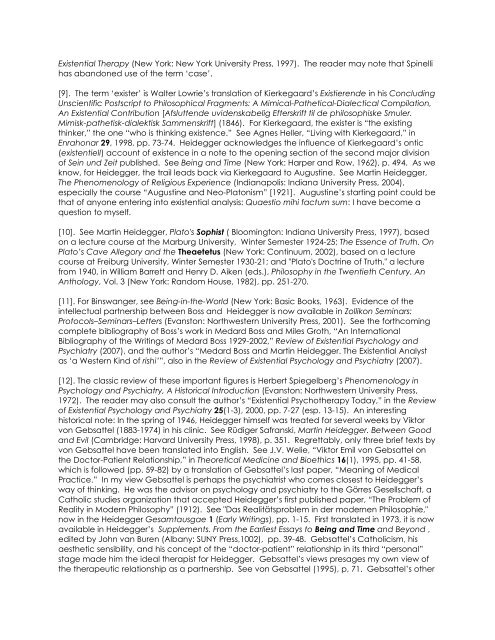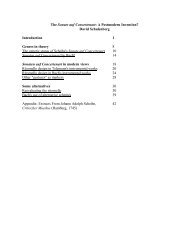SEVEN PAPERS ON EXISTENTIAL ANALYSIS ... - Wagner College
SEVEN PAPERS ON EXISTENTIAL ANALYSIS ... - Wagner College
SEVEN PAPERS ON EXISTENTIAL ANALYSIS ... - Wagner College
Create successful ePaper yourself
Turn your PDF publications into a flip-book with our unique Google optimized e-Paper software.
Existential Therapy (New York: New York University Press, 1997). The reader may note that Spinelli<br />
has abandoned use of the term ‘case’.<br />
[9]. The term ‘exister’ is Walter Lowrie’s translation of Kierkegaard’s Existierende in his Concluding<br />
Unscientific Postscript to Philosophical Fragments: A Mimical-Pathetical-Dialectical Compilation,<br />
An Existential Contribution [Afsluttende uvidenskabelig Efterskrift til de philosophiske Smuler.<br />
Mimisk-pathetisk-dialektisk Sammenskrift] (1846). For Kierkegaard, the exister is “the existing<br />
thinker,” the one “who is thinking existence.” See Agnes Heller, “Living with Kierkegaard,” in<br />
Enrahonar 29, 1998, pp. 73-74. Heidegger acknowledges the influence of Kierkegaard’s ontic<br />
(existentiell) account of existence in a note to the opening section of the second major division<br />
of Sein und Zeit published. See Being and Time (New York: Harper and Row, 1962), p. 494. As we<br />
know, for Heidegger, the trail leads back via Kierkegaard to Augustine. See Martin Heidegger,<br />
The Phenomenology of Religious Experience (Indianapolis: Indiana University Press, 2004),<br />
especially the course “Augustine and Neo-Platonism” [1921]. Augustine’s starting point could be<br />
that of anyone entering into existential analysis: Quaestio mihi factum sum: I have become a<br />
question to myself.<br />
[10]. See Martin Heidegger, Plato's Sophist ( Bloomington: Indiana University Press, 1997), based<br />
on a lecture course at the Marburg University, Winter Semester 1924-25; The Essence of Truth. On<br />
Plato’s Cave Allegory and the Theaetetus (New York: Continuum, 2002), based on a lecture<br />
course at Freiburg University, Winter Semester 1930-21; and "Plato's Doctrine of Truth," a lecture<br />
from 1940, in William Barrett and Henry D. Aiken (eds.), Philosophy in the Twentieth Century. An<br />
Anthology, Vol. 3 (New York: Random House, 1982), pp. 251-270.<br />
[11]. For Binswanger, see Being-in-the-World (New York: Basic Books, 1963). Evidence of the<br />
intellectual partnership between Boss and Heidegger is now available in Zollikon Seminars:<br />
Protocols–Seminars–Letters (Evanston: Northwestern University Press, 2001). See the forthcoming<br />
complete bibliography of Boss’s work in Medard Boss and Miles Groth, “An International<br />
Bibliography of the Writings of Medard Boss 1929-2002,” Review of Existential Psychology and<br />
Psychiatry (2007), and the author’s “Medard Boss and Martin Heidegger. The Existential Analyst<br />
as ‘a Western Kind of rishi’”, also in the Review of Existential Psychology and Psychiatry (2007).<br />
[12]. The classic review of these important figures is Herbert Spiegelberg’s Phenomenology in<br />
Psychology and Psychiatry, A Historical Introduction (Evanston: Northwestern University Press,<br />
1972). The reader may also consult the author’s “Existential Psychotherapy Today,” in the Review<br />
of Existential Psychology and Psychiatry 25(1-3), 2000, pp. 7-27 (esp. 13-15). An interesting<br />
historical note: In the spring of 1946, Heidegger himself was treated for several weeks by Viktor<br />
von Gebsattel (1883-1974) in his clinic. See Rüdiger Safranski, Martin Heidegger. Between Good<br />
and Evil (Cambridge: Harvard University Press, 1998), p. 351. Regrettably, only three brief texts by<br />
von Gebsattel have been translated into English. See J.V. Welie, “Viktor Emil von Gebsattel on<br />
the Doctor-Patient Relationship,” in Theoretical Medicine and Bioethics 16(1), 1995, pp. 41-58,<br />
which is followed (pp. 59-82) by a translation of Gebsattel’s last paper, “Meaning of Medical<br />
Practice.” In my view Gebsattel is perhaps the psychiatrist who comes closest to Heidegger’s<br />
way of thinking. He was the advisor on psychology and psychiatry to the Görres Gesellschaft, a<br />
Catholic studies organization that accepted Heidegger’s first published paper, “The Problem of<br />
Reality in Modern Philosophy” (1912). See "Das Realitätsproblem in der modernen Philosophie,"<br />
now in the Heidegger Gesamtausgae 1 (Early Writings), pp. 1-15. First translated in 1973, it is now<br />
available in Heidegger’s Supplements. From the Earliest Essays to Being and Time and Beyond ,<br />
edited by John van Buren (Albany: SUNY Press,1002), pp. 39-48. Gebsattel’s Catholicism, his<br />
aesthetic sensibility, and his concept of the “doctor-patient” relationship in its third “personal”<br />
stage made him the ideal therapist for Heidegger. Gebsattel’s views presages my own view of<br />
the therapeutic relationship as a partnership. See von Gebsattel (1995), p, 71. Gebsattel’s other















